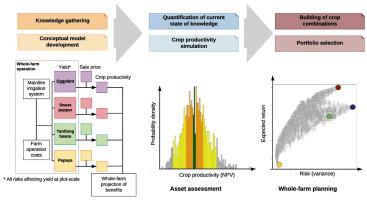Agricultural Systems ( IF 6.6 ) Pub Date : 2022-04-08 , DOI: 10.1016/j.agsy.2022.103409 Oscar Burbano-Figueroa 1, 2 , Alexandra Sierra-Monroy 2 , Adriana David-Hinestroza 2 , Cory Whitney 3 , Christian Borgemeister 1 , Eike Luedeling 3

|
CONTEXT
Even though diversification of horticultural production systems allows farmers to cope with risks and uncertainties, strategies for raising profitability usually aim to improve the productivity of monocultures rather than pursuing diversification. Horticultural production systems are often highly diversified in terms of land use and planted crops.
OBJECTIVE
Assessing the economic prospects of these complex systems requires quantification of productivity and related risks for individual crops as well as an assessment of the benefits from diversification. Here we demonstrate the implementation of a systematic assessment for irrigated production systems in the Sinú Valley of the Colombian Caribbean.
METHODS
We used participatory modeling approaches, focus group discussions and interviews to collect relevant qualitative and quantitative information from farmers. Quantitative information associated with input variables was elicited as probability distributions. Farmers were trained in estimation techniques, enabling them to provide reliable quantitative assessments of production-related variables.
RESULTS AND CONCLUSIONS
The model and elicited values for input variables were used to build a probabilistic simulation that allowed for estimating the expected income from horticultural crops and identifying portfolio strategies based on currently available horticultural options. The irrigated horticultural production systems of the Sinú Valley in Colombia contain four main crops. All farmers cultivate eggplants and sweet peppers but they have specific preferences for yardlong beans and papaya. These preferences reflect two crop diversification strategies attuned to farmers' resources. Yardlong beans are a short-term (3 months), low-risk, and low-profit investment (a tenth of the best crop option) while papaya is a long-term crop (18 months) of high-risk and profit. Yardlong beans are planted by smallholders with limited financial resources as a way to subsist and produce additional cash that can be invested in riskier more profitable crop options (eggplants and sweet peppers). This strategy describes a transition from a secure option (3 standard deviations (SD)) to riskier options (6 SD or more) that can generate greater profits. The second strategy describes actions of wealthier smallholders that can invest in short-lived perennial crops including papaya, sweet pepper and eggplants. This three-crop portfolio cuts production risks roughly in half (from 10 SD for the riskier option to 5 SD in the portfolio).
SIGNIFICANCE
We expect our decision analysis approach to prove useful in assessing other horticultural systems but also for the assessment and identification of new crop options to be incorporated in diversified systems. Our decision analysis approach can also be used to represent diversification in other whole-farm planning scenarios, e.g. when it comes to rotations of field crops, integrated livestock farms, cut-flower farming or agroforestry systems.
中文翻译:

风险下的农场规划:决策分析和投资组合理论在园艺系统作物多样化战略评估中的应用
语境
尽管园艺生产系统的多样化使农民能够应对风险和不确定性,但提高盈利能力的策略通常旨在提高单一栽培的生产力,而不是追求多样化。园艺生产系统在土地利用和种植作物方面往往高度多样化。
客观的
评估这些复杂系统的经济前景需要量化单个作物的生产力和相关风险,以及评估多样化带来的好处。在这里,我们展示了对哥伦比亚加勒比地区锡努河谷灌溉生产系统的系统评估的实施情况。
方法
我们使用参与式建模方法、焦点小组讨论和访谈从农民那里收集相关的定性和定量信息。与输入变量相关的定量信息被引出为概率分布。农民接受了估算技术培训,使他们能够对生产相关变量进行可靠的定量评估。
结果和结论
该模型和输入变量的引出值用于构建概率模拟,该模拟允许估计园艺作物的预期收入并根据当前可用的园艺选择确定投资组合策略。哥伦比亚西努河谷的灌溉园艺生产系统包含四种主要作物。所有农民都种植茄子和甜椒,但他们对一码豆和木瓜有特定的偏好。这些偏好反映了适应农民资源的两种作物多样化战略。Yardlong 豆是一种短期(3 个月)、低风险和低利润的投资(最佳作物选择的十分之一),而木瓜是一种高风险和高利润的长期作物(18 个月)。Yardlong 豆由财政资源有限的小农种植,作为维持生计和生产额外现金的一种方式,这些现金可以投资于风险更高、利润更高的作物选择(茄子和甜椒)。该策略描述了从安全选项(3 个标准差 (SD))到可以产生更大利润的风险更高的选项(6 个标准差或更多)的过渡。第二个策略描述了富裕的小农的行动,他们可以投资于短期的多年生作物,包括木瓜、甜椒和茄子。这种三作物组合将生产风险大致降低了一半(从风险较高的期权的 10 SD 降低到投资组合中的 5 SD)。该策略描述了从安全选项(3 个标准差 (SD))到可以产生更大利润的风险更高的选项(6 个标准差或更多)的过渡。第二个策略描述了富裕的小农的行动,他们可以投资于短期的多年生作物,包括木瓜、甜椒和茄子。这种三作物组合将生产风险大致降低了一半(从风险较高的期权的 10 SD 降低到投资组合中的 5 SD)。该策略描述了从安全选项(3 个标准差 (SD))到可以产生更大利润的风险更高的选项(6 个标准差或更多)的过渡。第二个策略描述了富裕的小农的行动,他们可以投资于短期的多年生作物,包括木瓜、甜椒和茄子。这种三作物组合将生产风险大致降低了一半(从风险较高的期权的 10 SD 降低到投资组合中的 5 SD)。
意义
我们希望我们的决策分析方法在评估其他园艺系统时证明是有用的,而且对于评估和确定要纳入多样化系统的新作物选择也是有用的。我们的决策分析方法也可用于代表其他全农场规划方案中的多样化,例如在大田作物轮作、综合牲畜农场、切花种植或农林业系统方面。


























 京公网安备 11010802027423号
京公网安备 11010802027423号